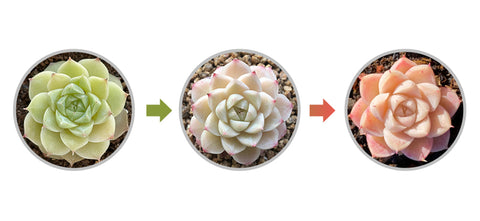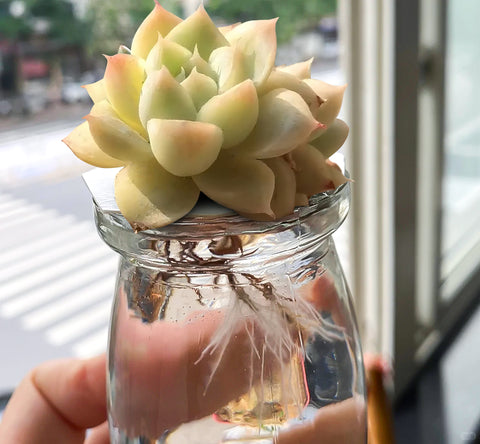Echeveria 'White Queen', a rare white succulent, is a must-have for those who appreciate the charm of light-colored succulents. It is a hybrid of Echeveria elegans 'alba,' preserving its distinctive white color and plump rosette shape. With robust triangular leaves, it exhibits sharp leaf tips that slightly curl outward. The leaves are coated with a thick layer of farina, creating mysterious white patterns on both the back and inside of the leaves. Under stress, the leaves unveil a subtle pinkish hue from the inside out, intensifying the color at the tips.
Let's delve into the care tips for Echeveria 'White Queen':
How to care for Echeveria 'White Queen'
Adequate Sunlight:
Don't hesitate to provide Echeveria 'White Queen' with extra sunlight, except during the summer. Succulents, including this one, thrive on sunlight, transforming beautifully without the risk of sunburn. Indoors, Echeveria 'White Queen' may appear pale green with limited light; however, ample sunlight will gradually turn it white, even pink.

Place your Echeveria 'White Queen' near a window for at least 10 hours of indirect sunlight or use a grow light for richer coloration. Allow it to bask outdoors in spring and fall, absorbing the sunlight.
Ideal Temperature:
Echeveria 'White Queen' is not demanding regarding temperature, surviving in the range of 40-95℉. However, it cannot tolerate temperatures below freezing, so bring it indoors during winter to prevent frost damage.
In high summer temperatures, shading is essential to prevent sunburn. The optimal color-changing period for Echeveria 'White Queen' is during spring, fall, and early winter when the temperature fluctuations prompt stress coloring, resulting in a pinkish tint.
Proper Watering:
Watering Echeveria 'White Queen' poses some challenges. While it generally follows the soak and dry method, its delicate roots require careful attention. Avoid over-controlling watering and shorten the intervals between watering to prevent root dehydration. You may wonder: How often should you water a succulent?
Soil and Pot:
Plant Echeveria 'White Queen' in well-draining succulent mix soil by combining succulent potting soil and gritty mix rocks in a 4:6 ratio. Choose a succulent pot with drainage holes for optimal results. As Echeveria 'White Queen' establishes its roots, stable growth will ensue.

Propagation Method:
Echeveria 'White Queen' is challenging to propagate through leaf cuttings.
Consider beheading propagation:
1. Select a healthy Echeveria 'White Queen'.
2. Cut from the base of the second layer of leaves using a small knife or string.
3. Let the obtained Echeveria 'White Queen' head dry in a shaded area.
4. Allow it to root by placing it on top of a water-filled container (without the base touching the water).
5. Once rooted, transplant Echeveria 'White Queen' into the soil.
6. Water approximately 1-2 weeks after transplantation.
You may wonder: The Ultimate Guide to Succulent Beheading Propagation.
Challenges in Caring for Echeveria 'White Queen'
Echeveria 'White Queen' poses unique challenges in its care, requiring special attention to ensure optimal health and appearance. Let's explore these challenges and how to overcome them:
Root Withering or Rot:
Due to the fragility of Echeveria 'White Queen's roots, they may wither or rot if the plant experiences dehydration. This genetic predisposition makes the succulent prone to root-related issues, leading to wilting and extensive leaf loss. To prevent such occurrences, it's advisable to shorten watering intervals slightly, allowing the soil to retain some moisture and sustain root vitality.
If your Echeveria 'White Queen' exhibits root withering, consider attempting water propagation to encourage root growth in a water-filled environment.

Emergence of Aerial Roots on Leaf Center:
A distinctive phenomenon in Echeveria 'White Queen' is the growth of aerial roots, typically appearing in the center of the leaves, often on the bottom second layer. This occurrence is usually indicative of underlying root problems. To address this, remove the affected lower leaves, encouraging the succulent to establish new roots.

Echeveria 'White Queen' vs. Echeveria elegans 'alba'
Echeveria elegans 'alba' can be considered the mother of Echeveria 'White Queen.' While both succulents exhibit a white coloration when stressed, they have distinct features and differences.
Echeveria elegans 'alba' features spoon-shaped leaves that wrap inward, presenting an overall enclosed appearance. In contrast, Echeveria 'White Queen' has triangular leaves with tips that slightly curl outward.
Conclusion
In summary, Echeveria 'White Queen' is a low-maintenance, aesthetically pleasing succulent that even beginners can cultivate successfully. Following care guidelines similar to other Echeveria varieties and paying particular attention to root health during the care process, your Echeveria 'White Queen' can become the captivating succulent queen in your garden.


























